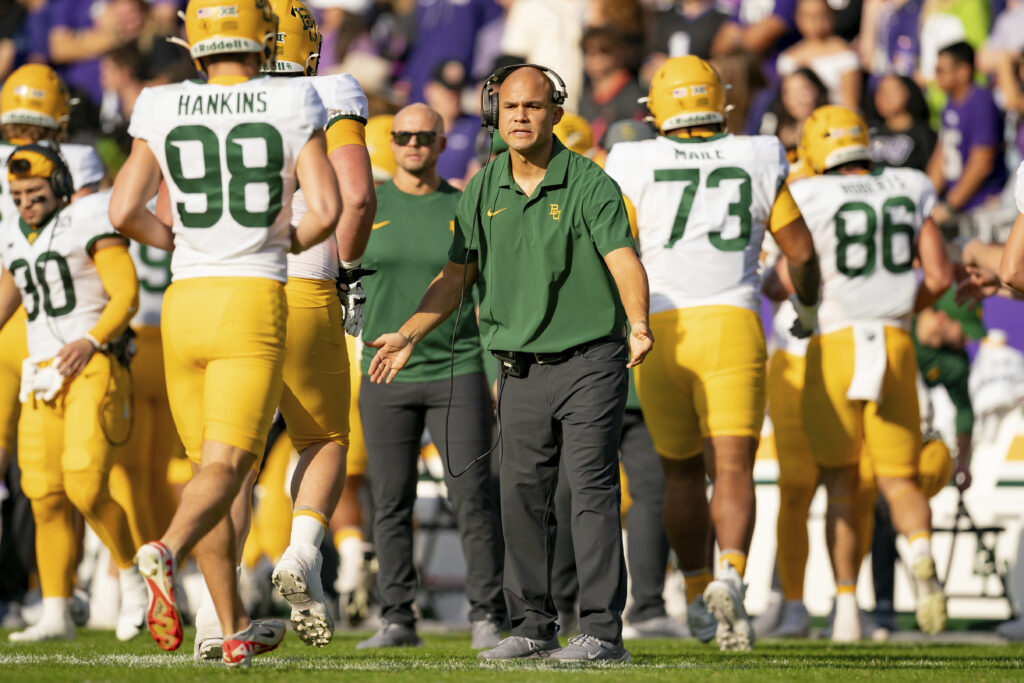1. Billy Napier – Florida
A High-Stakes Balancing Act
Billy Napier’s time in Gainesville is fast becoming a cautionary tale of what happens when a promising coaching hire collides head-on with the unforgiving realities of SEC football. After two-plus seasons at the helm of the Florida Gators, Napier has not only failed to ignite the fire fans had hoped for but also finds himself doused in a cold bath of doubt and second-guessing. His record? A tepid 11-15. His latest chapter? A 6-game losing skid that reads like a death spiral, punctuated by 11 losses in his last 14 outings against Power 5 competition.
Where Things Stand Now: A Program on the Brink
Napier’s Gators opened this season with a 41-17 faceplant against Miami—a performance with the Florida faithful clutching their pearls and boosters reaching for their checkbooks, not to invest but to buy out. The offense, lacking punch and rhythm, seems less like a coordinated attack and more like a jazz improvisation gone wrong. Meanwhile, the defense has been shredded with the kind of ease that has rivals circling like sharks in a tide of blood. And as if that weren’t enough, Nick Saban, the Oracle of Tuscaloosa, took a not-so-subtle jab at the program’s culture, suggesting it’s not up to SEC standards. When the godfather of college football speaks, the echo reverberates across the conference.
To add to Napier’s woes, he’s staring down the barrel of what many are calling the most challenging schedule in school history. No team in the country—not even a powerhouse like Florida—gets to skate by on mediocrity when the SEC gauntlet is loaded with landmines from top to bottom.
Pressure Cookers and Powder Kegs: Why Napier is Running Out of Time
If you’re a head coach at Florida, you’re not just managing a football team—you’re handling the emotional volatility of an entire state. And right now, the fanbase and boosters are running out of patience. Their expectations were sky-high when Napier arrived, believing he was the tactical mind who could return the Gators to glory. Instead, they’ve got a team that looks like it’s sleepwalking through the SEC. Add a string of early-season firings across college football and the precedent is set: no one is safe, not even in September.
But firing a coach isn’t as simple as pulling the plug. There’s the small matter of Napier’s buyout—an eye-watering $25 million if he’s let go this season. That’s the financial anchor that can keep even the hottest seats from spontaneously combusting. Plus, Florida’s historical tendency has been to at least give their head coaches until October.
The Road Ahead: A Future That Could Be Written in Weeks, Not Months
So, where does this leave Billy Napier? At a precipice, with both feet teetering over the edge. The next few weeks will be defining. You’d think last week’s win against Samford offered a brief reprieve, a momentary gasp of air, but it didn’t. A string of losses in SEC play could transform simmering discontent into outright mutiny. And at Florida, once the tide of booster sentiment turns, it can be impossible to turn back. The stakes? Enormous. The margin for error? Nonexistent. Napier isn’t just coaching for his job—he’s fighting to keep Florida from becoming another cautionary tale of how quickly things can fall apart in the unforgiving world of college football.
2. Sam Pittman – Arkansas
Arkansas: A Program Teetering on the Edge
For Sam Pittman, the head coach at Arkansas, the honeymoon phase has long since ended, and the stark reality of life in the SEC West has settled in. Coming off a nail-biting double-overtime loss to #16 Oklahoma State, 39-31, Pittman finds himself in a precarious position—caught between the promise of potential and the pressure of unmet expectations. And in Fayetteville, patience is not a virtue; it’s a fleeting luxury.
The Brutal Math of Close Games: A Coach’s Nightmare
Pittman’s record in close games tells the tale of a team that can’t seem to get out of its own way. Over the last two-plus seasons, the Razorbacks are a dismal 3-10 in games decided by seven points or less. That’s more than just bad luck; it’s a pattern. And patterns, especially the losing kind, have a way of becoming narratives that are hard to shake.
Mistakes, it seems, have been Pittman’s constant companion. Turnovers, penalties, and missed field goals are like recurring nightmares that the Razorbacks can’t wake up from. Even when the team shows flashes of brilliance, they stumble at the finish line. There’s a sense that they can compete, but when the clock’s winding down and the game’s on the line, they lack the killer instinct to close the deal.
Mounting Pressure: A Fanbase Running Out of Patience
There’s nothing like a season of self-inflicted wounds to turn up the heat on a head coach. After a disappointing 2023 campaign, Razorback fans are growing restless. They’re not just frustrated—they’re questioning whether Pittman can be the guy to lead this program back to relevance in a brutal SEC West. The expectations for 2024 were clear: show improvement, deliver wins, and reignite a fanbase that’s lost its spark. Anything short of that, and the whispers of discontent will grow into full-throated calls for change.
Pittman knows he’s not just coaching for his job—he’s managing a precarious balancing act between keeping fans engaged and maintaining the critical support of donors. Wins generate excitement, and excitement brings in money. Without either, the financial foundation of a program can start to look shaky.
Reasons for Hope? A Few Bright Spots Amid the Clouds
Still, it’s not all doom and gloom on The Hill. The Razorbacks showed fight in their double-overtime loss to a strong Oklahoma State team—enough to suggest that there’s some bite left in this squad. The schedule ahead also offers a glimmer of hope, with winnable games against UAB, Auburn, and Texas A&M. These matchups represent more than just potential wins; they’re lifelines for a coach whose seat is getting warmer by the week.
There’s also been a significant overhaul on the offensive side of the coaching staff, a move that signals Pittman is willing to make changes to right the ship. But in the cutthroat world of college football, especially in the SEC, moral victories and coaching shakeups only buy so much time. At some point, it comes down to one simple thing: winning.
The Weeks Ahead: Crunch Time for Pittman in Fayetteville
As it stands, Sam Pittman’s seat isn’t just warm—it’s on the verge of catching fire. The UAB game looms large, not just as a must-win but as a critical turning point for a season and, potentially, a tenure. Following that, the Razorbacks enter a gauntlet of SEC matchups against Auburn and Texas A&M. Wins in these games could provide Pittman the breathing room he desperately needs. Losses? They could make his seat unbearable.
In the high-stakes world of SEC football, every game is a referendum on a coach’s future. And for Sam Pittman, that future is hanging in the balance. If he can’t deliver victories—and soon—Arkansas Athletic Director Hunter Yurachek may have no choice but to start looking for a new direction.
3. Dave Aranda – Baylor
The Balance Between Defense and Desperation
Dave Aranda finds himself walking a tightrope at Baylor, where the promise of defensive prowess is increasingly overshadowed by offensive ineptitude. The Bears’ recent 23-12 loss to #11 Utah in Week 2 is just the latest chapter in a saga of struggles against top-tier competition. Baylor fans are left wondering if Aranda’s tenure, once filled with optimism after a Sugar Bowl win, is now defined more by frustration than by future hope.
Offensive Woes: The Achilles’ Heel of Aranda’s Bears
The crux of Baylor’s problems lies in an offense that seems perpetually stuck in neutral. Putting up only 48 total yards in the first half against Utah is more than just a bad stat line; it’s a glaring indictment of an attack that’s failed to gain traction. And it’s not just a one-off issue—since that triumphant Sugar Bowl win in 2022, Baylor has gone 0-9 against ranked opponents. The narrative has become painfully clear: this team can’t win shootouts, and it struggles to even compete when faced with top-tier talent.
Fans and analysts alike are beginning to point fingers at both the offensive play calling and the development—or lack thereof—of the quarterback position. The frustration is palpable. If you can’t trust your quarterback to lead an effective offense, what’s left? And if Baylor’s best strategy is to simply “keep it close” rather than dominate, how far can that really take them in the hyper-competitive Big 12?
Pressure Mounting: A Fanbase on Edge
As each week passes, the pressure on Aranda is ratcheting up. The patience in Waco is wearing thin, and for good reason. Baylor has aspirations to be more than just a middling program. They want to compete for Big 12 titles and, ideally, carve out a spot in the expanded College Football Playoff picture. Right now, though, those dreams seem distant.
Questions around offensive strategy, execution, and quarterback trust are only intensifying. There’s a growing sense that the Bears are not only underperforming but also fundamentally failing to live up to their potential. If the offense doesn’t start firing soon, that pressure could turn from uncomfortable to untenable.
Signs of Hope: A Defense That’s Standing Tall
Yet, all is not lost for Dave Aranda. There’s a reason his seat isn’t yet scorching. The defense—his bread and butter—has shown signs of life. In that loss to Utah, it wasn’t the defense that let Baylor down; in fact, Aranda’s defensive play-calling helped keep the game within reach, especially in the second half. The unit’s resilience offers a glimmer of hope in an otherwise bleak landscape, suggesting that the core principles Aranda brought with him are still intact.
Moreover, there’s been some visible progress compared to last season, however incremental it might seem. And if there’s one thing that can buy a coach time, it’s evidence that things might be moving in the right direction, however slowly.
The Path Ahead: Aranda’s Defining Stretch
But make no mistake: the road ahead is fraught with peril for Dave Aranda. His seat is warming, and the thermostat is set by an offense that needs to find its footing—fast. The upcoming game against Air Force and the slate of conference matchups to follow will be telling. If Baylor can’t find a way to generate offense and secure wins against quality opponents, no amount of defensive savvy will be able to save Aranda’s job.
In this league, moral victories and solid defensive stands aren’t enough. Wins are the currency that matters. And unless Aranda can find a way to cash in on the offensive side of the ball, his defensive acumen may not be enough to keep him in Waco. For now, the seat is warming, but the flame is close to catching.
4. Scott Satterfield – Cincinnati
The Clock is Ticking on Game Management Woes
Scott Satterfield’s tenure at Cincinnati has hit a critical juncture early in the season. After a gut-wrenching 28-27 loss to Pitt in Week 2—a game where the Bearcats squandered a commanding 21-point lead—Satterfield’s ability to lead this program is facing intense scrutiny. In the competitive landscape of the Big 12, there’s little room for repeated mistakes, and Satterfield’s track record is quickly becoming more of a liability than an asset.
The Core Problem: A History of Poor Game Management
The narrative around Satterfield is getting more damning by the week. His teams have developed a bad habit of faltering when the stakes are highest. A 4-15 record in one-score games since 2019, excluding the 2018 season at Louisville, tells the story of a coach who struggles to close the deal. Whether it’s blowing leads, like the recent meltdown against Pitt, or questionable play-calling and decision-making in high-pressure moments, Satterfield seems to find new ways to snatch defeat from the jaws of victory.
Cincinnati fans are already well-acquainted with the frustrations of last season, and the collapse against Pitt feels like an unwelcome déjà vu. The lack of composure and direction in critical situations is no longer just a trend; it’s a defining characteristic. And in the cutthroat environment of the Big 12, that’s not a reputation that leads to job security.
The Heat is On: Growing Discontent Among Fans and Boosters
The echoes of last season’s struggles are resonating loudly, and the fanbase is growing restless. What’s been most concerning isn’t just the losses, but the way they’ve come about. For a program transitioning into the Big 12, these kinds of collapses don’t just hurt the win-loss record; they erode trust in the direction of the team. Questions are mounting about Satterfield’s offensive strategy and his use of personnel. Are the Bearcats being put in the best position to succeed? So far, the results suggest otherwise.
And as frustration builds, so does the pressure. Cincinnati isn’t a program where mediocrity will be tolerated, especially with the increased visibility and expectations that come with Big 12 membership. The fanbase wants to see growth, adaptability, and most importantly, results. Anything short of that, and the calls for change will only grow louder.
Glimmers of Hope: Improvement Amidst the Chaos
Despite the growing heat on Satterfield, there are a few reasons for cautious optimism. The offense, while inconsistent, has shown flashes of potential improvement compared to last season. There have been standout individual performances, like Corey Kiner’s powerful rushing and Brendan Sorsby’s capable passing, that suggest the raw materials are there to build something more competitive.
Moreover, it’s still early in the season. There’s time to turn things around and prove that the collapse against Pitt was more an aberration than the norm. However, the window for proving that is narrowing rapidly.
The Weeks Ahead: A Make-or-Break Stretch for Satterfield
As it stands, Scott Satterfield’s seat is heating up, and fast. The upcoming game against Miami (OH) represents a crucial opportunity to regain some stability and momentum. More importantly, as Cincinnati heads into conference play, Satterfield must show he can manage games better and make the kinds of decisions that lead to wins, not heartbreaks.
If the Bearcats continue to stumble in winnable situations, Satterfield’s job security will be in serious jeopardy by mid-season. The path to redemption is clear but treacherous: demonstrate better game management, secure key victories, and give the fanbase a reason to believe that brighter days are ahead. If he fails to do so, Cincinnati may be looking for a new head coach sooner rather than later.
5. Joe Morehead – Akron
A Clock Ticking Louder in the MAC
Joe Moorhead’s journey at Akron has been anything but smooth, and after a brutal 52-6 loss to #2 Ohio State in the season opener, the path forward looks no easier. With just four wins in his first two years and an admission from Moorhead himself that Akron is “the worst football program in Division I football,” the reality is stark: this program is struggling to find any semblance of upward momentum.
The Heart of the Problem: A Program Stuck in Neutral
Three years into his tenure, Moorhead is facing the same criticisms that have haunted him from the start. Akron has lost ten one-score games in the past two seasons, including four in overtime—games that, with better execution or strategy, could have turned the tide for a beleaguered program. Instead, they stand as missed opportunities that underscore a worrying inability to finish strong.
There’s a sense that Akron’s struggles are not just tactical but psychological; the losing culture has dug deep roots, and Moorhead’s efforts to shift the belief system among his players haven’t yet borne fruit. When a head coach describes his own team in such dire terms, it raises the question: has Moorhead already lost faith in his ability to turn things around?
The Heat is Rising: A MAC Crisis in the Making
For a program like Akron, where the competitive bar in the MAC is relatively low, continued poor performance only serves to amplify the pressure on Moorhead. The inability to close out close games and break free from the cycle of losing has left fans and boosters increasingly restless. The whispers of frustration are growing louder with each passing week.
The expectation when Moorhead arrived was that he would leverage his reputation as one of the top offensive minds in college football to spark a turnaround. Instead, the Zips remain mired in mediocrity, with little sign that the corner is about to be turned.
A Glimmer of Hope: Mitigating Circumstances and Marginal Gains
However, Moorhead’s seat isn’t yet burning for a few reasons. His standing as a respected offensive strategist still carries weight, and there have been some areas of improvement, particularly in special teams play. Plus, it’s important to remember that the early part of Akron’s schedule hasn’t been forgiving—facing powerhouses like Ohio State and Rutgers makes any immediate turnaround hard to judge.
But Akron’s true test lies ahead in its MAC schedule. These are the games that Moorhead was brought in to win, and they represent his last, best hope to show significant progress.
The Path Ahead: A Make-or-Break Moment for Moorhead
As the MAC slate looms, Joe Moorhead finds himself at a crossroads. His seat is warming, and the thermostat is directly tied to Akron’s performance in winnable conference games. If the Zips can’t find a way to string together some victories and show tangible improvement, Moorhead may find himself looking for a way out—potentially back to the role of offensive coordinator, where his reputation still holds value.
For now, the heat is on but not yet scorching. However, if Akron continues on its current trajectory, Moorhead’s days in the lead chair could be numbered. The rest of this season is crucial, and it’s make-or-break time for the man tasked with fixing a program that’s been broken for far too long.








